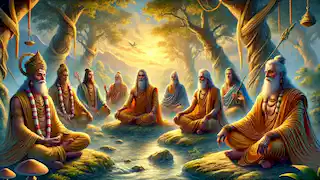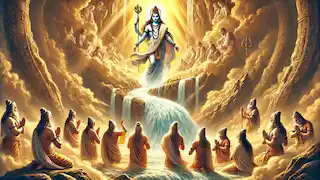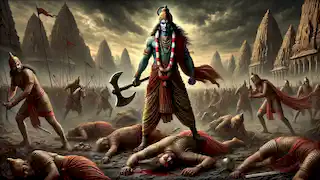The Tale of the Seven Sages
Reading time: 10 min

About this story: The Tale of the Seven Sages is a Myth from India set in the Ancient This Dramatic tale explores themes of Wisdom and is suitable for All Ages. It offers Cultural insights. The cosmic journey of India's Seven Great Sages.
Introduction
Long ago, in the mystical land of Bharatvarsha (ancient India), the cosmos was watched over by the eternal spirits known as the Saptarishi, the Seven Great Sages. These celestial beings, created by Lord Brahma—the Creator of the universe—were endowed with wisdom and power beyond comprehension. They guided the world through the darkest of times and the most prosperous of ages, ensuring the balance of dharma, or righteousness, on Earth.
The Saptarishi held the sacred responsibility of teaching humanity, offering them wisdom through their spiritual practices, sciences, and ethics. They were the ones who bridged the realms of gods and men, revealing the deeper truths of existence. Yet, their influence extended beyond the earthly plane. Their wisdom reached out to the stars, for they were the guardians of cosmic knowledge and protectors of divine secrets.
The sages were not mere mortals. They could transcend time and space, witnessing the rise and fall of civilizations, watching the birth and death of stars. Though often invisible to the ordinary eye, their presence could be felt by those who sought the truth, those who walked the path of enlightenment.
Their names—Vashishta, Vishwamitra, Atri, Bharadwaja, Gautama, Jamadagni, and Kashyapa—resonated through the ancient Vedic texts and scriptures, their teachings forming the very foundation of Vedic knowledge. Yet, while they shared a common purpose, each of the sages followed a unique path, contributing to the spiritual fabric of the world in their distinct ways.
This is the story of their journey, of the trials and tribulations that shaped them into the great celestial beings they were destined to become. It is the story of their role in preserving the universe, and of their eternal bond with the cosmos.
The Birth of the Seven Sages
In the beginning, there was only the vast, unending ocean of primordial energy, waiting to be shaped into creation. From this void arose Lord Brahma, the first being, the architect of all existence. As he looked upon the formless expanse, he realized that in order to shape the universe, he needed guardians—beings who could watch over the different aspects of creation and ensure its harmony.
Thus, Brahma created the Saptarishi, seven souls born of the purest divine energy. Each sage was gifted with immense wisdom and power, their essence embodying different aspects of life and knowledge.
Vashishta, the eldest of the seven, was granted mastery over the spiritual laws of the universe. His wisdom was like the unshakable roots of a sacred tree, providing nourishment and support to all life. Vishwamitra, once a king turned sage, represented the unyielding strength of will, capable of bending even the gods to his commands through his intense austerities. Atri, known for his meditative prowess, embodied the principle of tranquility, guiding the mind toward stillness and enlightenment.
Bharadwaja, the sage of scientific inquiry, unlocked the mysteries of medicine, astronomy, and other earthly sciences. Gautama, the seeker of truth and moral integrity, taught the principles of justice and righteousness. Jamadagni, fiery and disciplined, was a master of warfare and the embodiment of divine retribution. Finally, Kashyapa, the father of all living beings, was the guardian of creation and progenitor of countless races of gods, demons, and humans.
Together, these sages formed a powerful council, their divine intellect shaping the course of the universe. Their wisdom was sought by kings and gods alike, for their knowledge spanned both the material and spiritual worlds.
One day, as they sat meditating at the banks of the celestial river Saraswati, the great deity Narada, the wandering sage, approached them. “Oh, great Rishis,” Narada began, “The world is growing restless. Men have lost their path, and the asuras (demons) are growing in power. They seek to topple the order of creation. What will you do to restore balance?”
The Saptarishi opened their eyes, their minds already sensing the turmoil spreading across the realms. They understood that it was their sacred duty to restore harmony, to guide humanity back to the path of righteousness and to challenge the forces of darkness that sought to unravel the fabric of existence.
Thus began their journey, a mission that would test their wisdom, patience, and powers beyond anything they had encountered before.
Vashishta and Vishwamitra’s Rivalry
The harmony of the Saptarishi was occasionally disrupted by the intense rivalry between Vashishta and Vishwamitra. Vishwamitra, once a mighty king, had renounced his kingdom and sought to attain the status of a Brahmarishi, the highest rank of sagehood, which Vashishta had already achieved.
Vishwamitra’s path was filled with challenges, as his fiery nature often brought him into conflict with his elder counterpart. In his early days, Vishwamitra had once tried to seize Vashishta’s cow, Nandini, a divine bovine capable of granting any wish. Vashishta, however, easily subdued Vishwamitra’s forces with the cow’s divine powers, humiliating the former king.
This incident had ignited a fierce desire within Vishwamitra to surpass Vashishta. For many years, he performed intense penances, seeking to gain mastery over divine weapons and tap into the power of the gods. His austerities impressed even the Supreme Deity, Lord Shiva, who bestowed upon him celestial powers.
But no matter how much power Vishwamitra attained, he struggled to gain the title of Brahmarishi, for that title was reserved for those who had mastered not only the material and celestial worlds but also their own egos. Vishwamitra’s anger and pride often stood in his way.
One day, after centuries of meditation and penance, Vishwamitra approached Vashishta, ready to challenge him once more. As they stood face to face, the tension between the two sages was palpable. Yet this time, something was different. Vishwamitra had finally realized the futility of his quest for superiority. Instead of engaging in a battle, he bowed before Vashishta, his heart filled with humility and respect.
Vashishta, seeing the transformation in his rival, smiled. “You have finally understood the true essence of Brahmarishi,” he said. “It is not power that defines a sage but the mastery of one’s own self.”
In that moment, Vishwamitra’s pride dissolved, and he was granted the title of Brahmarishi, standing as an equal alongside Vashishta. Their rivalry transformed into mutual respect, and their combined wisdom strengthened the Saptarishi’s efforts to guide the world.

The Descent of the River Ganga
One of the most significant moments in the history of the Saptarishi was their role in bringing the sacred river Ganga to Earth. The Earth had been suffering from a terrible drought, and the gods, led by King Bhagiratha, sought the help of the Saptarishi to bring the divine waters of the Ganga from the heavens to Earth.
However, the descent of Ganga was not a simple task. Her force was so immense that if she descended upon the Earth without control, she would flood the entire planet. The Saptarishi, understanding the gravity of the situation, prayed to Lord Shiva, the destroyer and protector of the universe.
Shiva, in his infinite wisdom, agreed to catch the river in his mighty locks, allowing her waters to flow gently onto the Earth. With the Saptarishi guiding the process, Ganga descended from the heavens, bringing life and prosperity to the parched lands.
This event became one of the most celebrated moments in Indian mythology, symbolizing the union of heaven and Earth through the efforts of both gods and sages. The Saptarishi’s wisdom and connection to the divine once again restored balance to the world.

Atri and Anasuya
Among the Saptarishi, Atri was known for his deep meditation and his devoted wife, Anasuya, who was revered for her purity and virtue. Anasuya’s devotion to her husband was so powerful that it caught the attention of the Trimurti, the three supreme deities—Brahma, Vishnu, and Shiva.
One day, the Trimurti decided to test Anasuya’s devotion. They appeared before her in the guise of wandering sages and asked her for alms. However, they requested that she serve them without wearing any clothes, hoping to break her resolve.
Anasuya, undeterred by their challenge, agreed to their request, but through her pure heart and unwavering faith, she transformed the three gods into innocent infants. She cared for them as her own children, demonstrating her ultimate devotion to dharma and her husband.
Impressed by her virtue, the Trimurti restored themselves to their original forms and blessed both Atri and Anasuya. From this blessing was born the great sage Dattatreya, an incarnation of the Trimurti, who embodied the combined powers of creation, preservation, and destruction.
Atri and Anasuya’s story became a timeless example of the power of devotion and the importance of purity in both action and thought.

The Curse of Jamadagni
Jamadagni, one of the most powerful of the Saptarishi, was known for his discipline and
strict adherence to the rules of dharma. He had a divine cow, Kamadhenu, which could grant any wish and provide for all the needs of his household.
However, his strictness often caused conflict with those around him. One day, the king Kartavirya Arjuna, a powerful but arrogant ruler, visited Jamadagni’s ashram and demanded Kamadhenu for himself. Jamadagni refused, enraging the king. Kartavirya Arjuna attacked the sage’s ashram, killing Jamadagni and stealing the cow.
When Jamadagni’s son, the mighty warrior-sage Parashurama, returned and learned of the injustice, he flew into a rage. Parashurama vowed to take revenge on the Kshatriya (warrior) class, whom he held responsible for his father’s death. In a bloody campaign, he wiped out the Kshatriya kings twenty-one times, forever altering the balance of power on Earth.
Although Parashurama’s actions were driven by grief and a sense of duty, they also caused great turmoil. The Saptarishi, along with other sages, had to work tirelessly to restore peace and order in the world after Parashurama’s devastating campaign.

Kashyapa and the Creation of Life
Kashyapa, the last of the Saptarishi, was known as the father of all living beings. His wisdom in the creation of life made him one of the most revered sages in the universe. Through his many wives, Kashyapa became the progenitor of gods, demons, animals, and humans, ensuring that life in all its forms continued to flourish.
Kashyapa’s role as the creator of life made him a vital figure in maintaining the balance of the universe. Through his efforts, the different races and creatures of the cosmos found their place, each contributing to the grand design of creation.
Yet, Kashyapa’s task was not without its challenges. The forces of chaos often sought to upset the balance of life, and it was through his unwavering dedication that he maintained harmony between the different realms. His wisdom, combined with the collective strength of the Saptarishi, ensured that the universe continued to thrive.
Conclusion: The Eternal Saptarishi
The Saptarishi’s legacy is one of eternal vigilance, wisdom, and compassion. They have transcended the boundaries of time and space, watching over the world from their celestial abode, guiding humanity through the ages. Their teachings have shaped the spiritual foundation of India, their names forever etched in the sacred texts.
Even today, the Saptarishi continue to guide those who seek the truth, their presence felt in the stars as the constellation Ursa Major, where they reside in eternal meditation, preserving the balance of the universe.

















